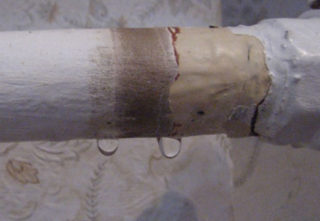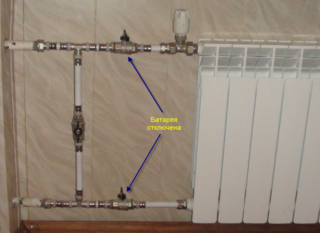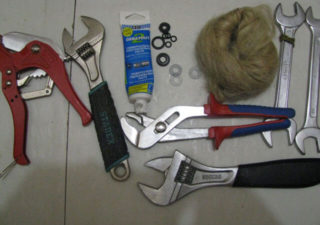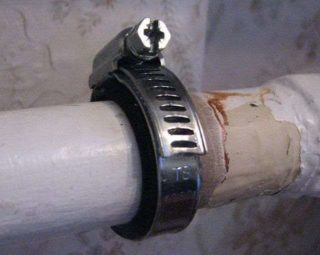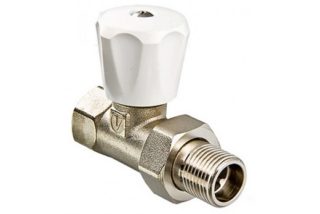Central heating in an apartment and autonomous in a private house is a valuable system for a person, thanks to which life has become much simpler and more comfortable. There is no need to monitor the outbreak and constantly refuel it. However, in addition to the bill for payments, these systems have a serious drawback - inevitable breakdowns, the consequences of which can reach catastrophic proportions. However, if a heating battery leaks, this is not a tragedy. Knowing what to do in such cases, you can easily and quickly deal with the problem. You can fix the situation with your own hands without spending money on hired plumbers.
The main types of damage to heating batteries
In order to correctly and reliably eliminate a leak in a pipe or in a radiator, you need to know and well understand the nature of the occurrence of such a phenomenon.
The formation of gaps and holes occurs for the following reasons:
- metal corrosion resulting from the contact of black iron with oxygen present in air and water;
- the use of low-quality material in the assembly of the structure;
- water hammer, the consequence of which is the appearance of cracks;
- wear of gaskets installed at joints and in places of threaded joints;
- mechanical damage associated with a hard blow by a hard object during the repair or movement of household appliances;
- violation of assembly technology and welding during installation.
All these prerequisites lead to the appearance of breakdowns of this nature:
- Slots in the radiator. Such malfunctions are the most unpleasant, as they appear in complex, sometimes inaccessible places. Sometimes water covers several ribs or the entire product. Most often, the heating battery flows at the junction of the sections. This occurs due to drying of the gasket or increased pressure in the pipeline. Less commonly, holes form in the housing. The reason for this lies in manufacturing defects, which cannot be identified at the installation stage, since the defect manifests itself over time.
- Through cracks in the pipes. They are the result of low-quality welding or factory defects. Most often occur at the seams of the strapping pipes, at the places of their junction with each other and with the riser. Often the problem arises due to electrolytic corrosion, when property owners close zero or ground from household appliances to the heating circuit.
- Freezing or overheating of the pipeline. A common problem for country houses and cottages, sometimes arising in the urban sector. Expanding during freezing, water breaks the metal, leaving cracks on it of various widths and lengths. You may not immediately notice them, but when the water thaws, the defect will immediately appear. Upon overheating, thermal expansion of iron occurs. If the communications have nowhere to move, in weak places they are destroyed, burst or crack.
- Cracks in the joints of batteries and pipes. Leakage occurs due to a leak in the joint. The most common cause is metal corrosion as a result of the weld joint. Sometimes a hole is formed due to the inexperience or negligence of the master, who left a thin layer of metal at the seams. The problem of leakage may be in the wrong choice of the installation location of the bearing anchors, when mechanical stress arises due to skew. A pipe often flows after people have stood on it or suspended heavy objects.
Knowing the causes of problems with heating utilities, you should prepare in advance to eliminate pipe leaks, so breakage can occur at any time.
Problem Solving Materials and Tools
The presence of a minimum set of household tools and consumables allows you to repair leaky pipes, radiators and risers.
The list of tools and devices necessary to solve emergency situations:
- plumbing pliers, adjustable spanner, pliers;
- grinder, puncher, screwdriver, welding machine;
- scissors;
- metal brush;
- devices for making threads;
- calipers;
- aluminum wire;
- old bicycle luggage;
- steel clamps.
When the battery or harness is flowing, large volumes of water may leak out of the holes. In constant readiness, you need to have rags and containers for its emergency collection. In addition, you should purchase a construction mask and thick silicone gloves to avoid burns and cuts.
If a pipe, cast-iron or aluminum radiator has leaked, you can use one of the following methods to eliminate the malfunction:
- Self-tapping bolt. An effective option for sealing holes of small size and close to a circle shape. The type of metal in which the hole is formed should be considered. The bolt will fit perfectly into steel and aluminum, but not into cast iron, which is brittle. A hole is drilled under a self-tapping screw, then with a plastic washer mounted, it is screwed into the damaged fragment. The advantage of this solution is that it is feasible even when the system is under pressure in working condition.
- Rubber pad with wire or clamp. Also a repair option without shutting off the water supply. The advantages of the method are that it does not require any preparation and implementation of preliminary steps. It is necessary several times to tightly wrap the rubber around the hole, then fix it with clamps or thick wire. Instead of rubber, you can use the FUM tape, which almost every home master has. The result of the work will not be the most aesthetic, but the problem will be solved. There will be enough pads until the end of the heating season, after which you can change the defective fragment or carry out professional repairs.
- Cement-gypsum dressing. This method is applicable only to a drained heating circuit. It is necessary to knead a solution of cement, gypsum and water in a ratio of 1: 1: 1. An ordinary medical bandage is immersed in it and, after swelling, is wrapped around a pipe or joint in a radiator. To achieve sufficient strength and tightness, at least 10 turns must be made. It usually takes 30-40 minutes to solidify the mixture.
- Fabric impregnated with heat and water resistant adhesive. The method is similar to that described above. You can buy such glue in any hardware store. If this has not been done well in advance, epoxy can be used. A two-component solution is kneaded in a ratio of 10: 1, after which it is lowered into it, a cloth or bandage is soaked, and then wrapped around the damaged area. Depending on the brand of resin, it completely hardens within 15-120 minutes.
- Special sealant. There are universal compounds, as well as designed for a specific metal. If the heating pipe leaks, you can cover it with sealant after draining the system or a separate section. The plastic glue is kneaded to a soft state, after which it is pressed into the hole. Then, using a thin sharp object of that part of the substance that is inside the pipe, expansion is given so that it overlaps the edges of the gap. After this, another layer of glue is applied and the desired shape is given to it.The polymer cork freezes in a matter of minutes, the material is waterproof, resistant to chemically active substances and high temperatures. This method is so effective that if you seal the pipe with water with a sealant, you can not repair it until the end of the life of the heating system.
- Welding. This method is the most reliable, but not always available and applicable. Leaks often occur in places inaccessible to the electrode. Not every house and apartment has a welding machine. Another difficulty is that you need to have at hand material for a patch of a certain size and configuration. Before closing a hole by welding, the metal around it must be cleaned of paint and rust. Otherwise, the connection will be leaking and will leak.
Since leaks are detected only in the process of powering the system and during the heating season, one should be prepared for the development of events in this period.
Procedure for repairing leaks
Since there are many reasons for leaks in the elements of the heating system, a universal way to eliminate them simply does not exist. You need to choose the option quickly, since a large amount of spilled water is fraught with serious consequences not only for the interior and decoration of the room, but also for the apartments located below in a multi-storey building.
The following procedure is recommended:
- Locate leakage. Substitute a basin or pan under the stream immediately. If the jet hits up or to the side, it is necessary to throw a cloth over the hole, and bring its edge into the tank. Throw as much tissue as possible on the floor so that it absorbs liquid. If there is a threat of flooding of electrical devices, raise them to a high place - a sofa, a shelf, a windowsill. After this, liquid that spills onto the floor is urgently collected. For this, rags, scoops, basins, buckets, a washing vacuum cleaner are used. To reduce heat and remove steam to improve visibility, you need to open a window and arrange a draft.
- Block the water. In a private mansion, this is not difficult to do - just go down to the basement and turn off the water tap. In a multi-storey building, this is more difficult to accomplish, since the plumbing or the responsible person may not be in place. In such cases, if water is poured out of the system in large volumes, a responsible decision must be made - to knock down the door from the door, enter the basement and block the emergency riser. Find it is not difficult, focusing on the distance from the front door. If the equipment is new and there are pressure gauges on it, the desired pipe can be found by lower pressure readings. In any case, this decision is justified - it is better for people to sit for several hours with cold batteries in one room than to be flooded.
- Malfunction elimination. The repair method may be local or global. If the damage is minor, it is repaired by minor intervention - a bandage is applied to the pipe, a screw is screwed in or a wooden chopstick is driven into the hole. When the gap is so large that it is not possible to close it with improvised means, you will have to drain the water, conduct local replacement of individual sections or the entire internal wiring.
A correct and quick response to a heating leak will save time, nerves and money for the residents of the emergency apartment and their neighbors on the porch.
Do it yourself
Even having knowledge of leakage elimination and a complete set of equipment necessary for this, it is not always possible to fully apply your skills in practice.
Often it is not possible to shut off and drain the water.The example is simple - a powerful steel door leads to the basement, a plumber has a key, and he went on a weekend to a neighboring city or region.
There is only one way out - to work under pressure and exposure to critically hot water. Initially, it is necessary to organize the collection of water in the tank from the hole and effective ventilation. Then measures should be taken to protect the skin, organs of vision and breathing from hot water and steam. A good help is waterproof winter clothing for hiking.
After wearing protective clothing, you can begin to work. Choose a self-tapping screw with a silicone washer, a rubber winding or a wooden wedge.
If you managed to stop the water and drain the faulty area, you can fix it without welding. There are many ways to do this: wrapping a cloth dampened with a sealant, rivets, a self-tapping screw, a polymer plug. The choice depends on the time allotted for the repair.
